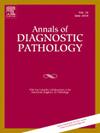髓母细胞瘤的免疫组织化学分子分类:单中心研究
IF 1.4
4区 医学
Q3 PATHOLOGY
引用次数: 0
摘要
髓母细胞瘤(MB)是第二常见的小儿中枢神经系统恶性肿瘤。世界卫生组织(WHO)提倡综合病理和分子诊断方法。免疫组织化学(IHC)已被证明是低资源环境下分子分型的有效替代方法。本研究旨在利用免疫组化将MB分为不同的分子亚型。2011年至2021年间诊断为成神经管细胞瘤的患者被纳入研究。回顾了临床病理特征、治疗模式和结果。使用β-catenin、Yes-associated protein 1 (YAP1)和GRB2-Associated Binding protein 1 (GAB1)抗体,通过免疫组化染色将分子亚群分为无翼信号激活(WNT)、sonic hedgehog (SHH)和非WNT/非SHH。32例患儿的平均诊断年龄为9.9岁,M: F比值为1.5:1。经典(75.8%)和结缔组织增生/结节(24.2%)是仅有的两种组织病理学变异。非WNT/非SHH占大多数(54.5%),其次是SHH(36.4%)和WNT亚群(9.1%)。5年总生存率和5年无进展生存率分别为41%和38%。手术30天死亡率28.1%。通过免疫组织化学确定的分子亚群,可以很容易地纳入低资源环境的常规实践。由于高术后死亡率和低辅助肿瘤治疗的吸收,我们队列的总生存率低于文献报道。本文章由计算机程序翻译,如有差异,请以英文原文为准。
Molecular classification of medulloblastoma using immunohistochemistry: A single centre study
Medulloblastoma (MB) is the second most common malignant paediatric central nervous system (CNS) tumour. The World Health Organisation (WHO) advocates an integrated pathological and molecular approach to diagnosis. Immunohistochemistry (IHC) has been proven to be a valid surrogate for molecular subtyping in low resource settings. This study aimed to use IHC to classify MB into different molecular subtypes.
Patients diagnosed with medulloblastoma between 2011 and 2021 were included in the study. Clinicopathological characteristics, treatment patterns and outcomes were reviewed. Molecular subgrouping into wingless signalling activated (WNT), sonic hedgehog (SHH), and non-WNT/non-SHH was performed by immunohistochemical staining, using β-catenin, Yes-associated protein 1 (YAP1) and GRB2-Associated Binding Protein 1 (GAB1) antibodies.
Of the 32 children evaluated, the mean age at diagnosis was 9.9 years with M: F ratio of 1.5:1. Classic (75.8 %) and desmoplastic/nodular (24.2 %) were the only two histopathological variants reported. Non-WNT/non-SHH constituted the majority of cases (54.5 %), followed by SHH (36.4 %) and WNT subgroups (9.1 %). The 5-year overall survival and 5-year progression-free survival was 41 % and 38 % respectively. The 30-day operative mortality rate was 28.1 %.
Molecular subgroups determined by immunohistochemistry, can be easily incorporated into routine practice in low resource settings. The overall survival rate in our cohort is lower than thate reported in the literature due to high post-operative mortality and low uptake of adjuvant oncotherapy.
求助全文
通过发布文献求助,成功后即可免费获取论文全文。
去求助
来源期刊
CiteScore
3.90
自引率
5.00%
发文量
149
审稿时长
26 days
期刊介绍:
A peer-reviewed journal devoted to the publication of articles dealing with traditional morphologic studies using standard diagnostic techniques and stressing clinicopathological correlations and scientific observation of relevance to the daily practice of pathology. Special features include pathologic-radiologic correlations and pathologic-cytologic correlations.

 求助内容:
求助内容: 应助结果提醒方式:
应助结果提醒方式:


